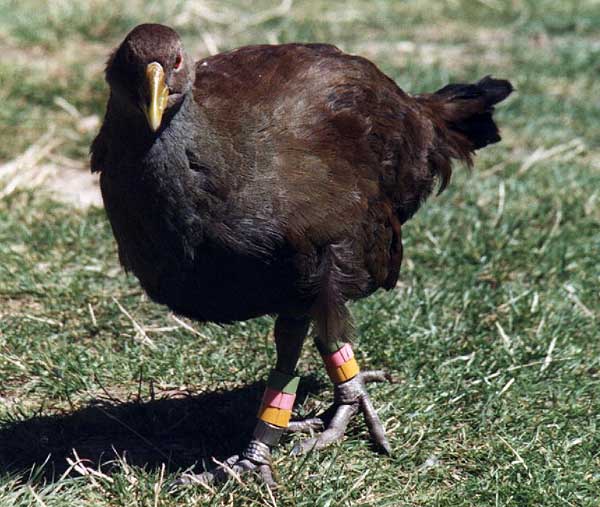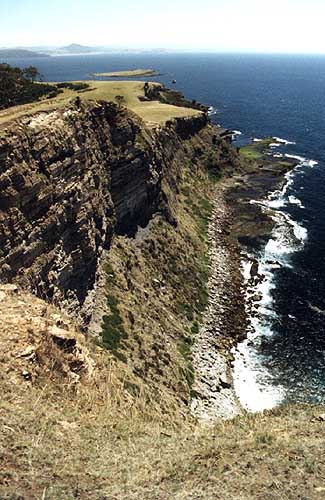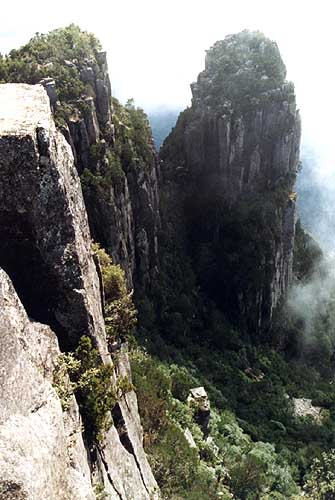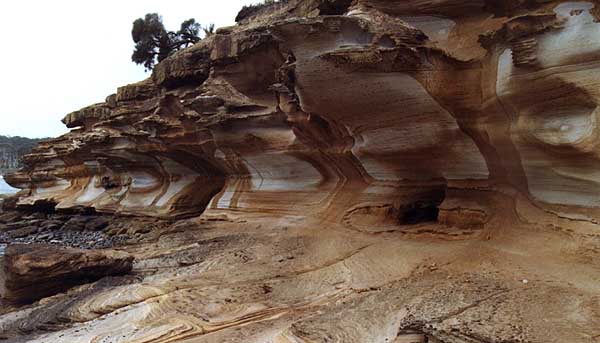|
Numerous people had told us that Maria Island was well worth a visit. Midway between Freycinet and Hobart, the island was first sighted by Abel Tasman in 1642 and has had a colourful history since that time. Originally a penal settlement, Maria Island has also been used for grazing and cement manufacturing by a variety of entrepreneurs. Forty years ago the Tasmanian government gradually began acquiring the island's land, until 1972 when it was declared a national park.

A Tasmanian Native Hen on Maria Island
Karen and I had an additional reason to travel to the island as well. Not only is the island rich in history and extremely scenic, it is also a haven for an endangered bird - the Forty-spotted Pardalote. A couple of days after leaving Freycinet, Karen and I ferried across to Maria Island for an extended stay.
Our first attempts to sight the Pardalote were largely unsuccessful. The birds are known to feed amongst the leaves of manna gums, which unfortunately are a couple of hundred feet high. In addition, the Pardalote is one of Australia's smallest birds, so observation and identification was very difficult. After following a track to a small dam where the birds had often been seen, Karen and I were forced to lay on the ground in order to scan the treetops with binoculars. We must have appeared totally ridiculous to the other island visitors who walked by, but our efforts did not go unrewarded. We could see small birds in the canopy, but after half an hour of careful observation we agreed that it was likely - but not definite - that the birds we were seeing were the desired birds. The situation was complicated by the presence on the island of a similar related species - the spotted Pardalote. Our time was not totally wasted though, with a sighting of another rare bird - the swift Parrot - plus two other new ticks - the strong-billed Honeyeater and the black-headed Honeyeater.
Another walk on the island took us around the main settlement of Darlington on a history tour, which we augmented with a longer self-guided tour afterwards. Karen loves learning about the history of the places we visit, but I can usually take it or leave it. Even so, I have to admit that the island is worth visiting for its history alone.
Maria Island is easily visible from the mainland, and Karen and I had also seen it from the top of Mount Graham on Freycinet as well. Its highest point is the seven hundred metre Mount Maria, a prominence on a tree covered ridge. At the north end of the ridge, and clearly visible from Darlington, are two conspicuous outcrops known as Bishop and Clerk, composed of bare dolerite rock and over six hundred metres above sea level. When our second day on the island dawned bright and sunny, Karen and I set out for their summits.

The cliffs of Fossil Bay
The walk took us east to the edge of Fossil Bay, ringed by a huge curve of high cliffs. A track led upwards along the top of the cliff where regular warning signs alerted tourists to the dangers of getting too close to the edge. The climb steepened at the end of the cliff as the track rose through forest to the base of a large scree slope of dolerite rocks. A succession of stakes marked the track up the slope. At the top the track continued upwards through stunted vegetation and over and around large columns of rock which required a bit of scrambling. The summit was surprisingly small, a couple of platforms only a few metres across.
The views were absolutely incredible. A vertical drop of a couple of hundred metres ended in a steep, narrow, slope that plunged into the ocean. We were two thousand feet up, but I felt that a well thrown rock would easily reach the water. Away to our left the ridge dropped down via a series of spectacular columns. The cliffs we had recently walked above were visible to the north-west, but they were now dwarfed almost to insignificance. To the west lay the open ground and the scattered buildings of the Darlington settlement, and further to the west across the water was Tasmania.
Karen and I had looked at the maps and noted that Mount Maria was not too far away. We thought we would be able to walk along the ridge to the high point and then follow the Mount Maria walking track back down to Darlington, but one look at the vegetation soon put that thought completely out of our minds. Unlike the open ridges we were used to on the mainland, the ridge we now faced was completely overgrown with incredibly dense, gnarled scrub. A traverse was simply impossible.
A few minutes after arriving at the summit, I grabbed my camera and began looking for the best vantage points. Before I could compose a single shot, however, our views were totally obscured by a sudden mist which completely enveloped us. A moist breeze blowing in from the sea was being forced upwards by the cliffs, the moisture condensing into clouds around us. The views were too incredible for me to let them go unrecorded, so we waited around for a while, hoping the mist would clear. After about half an hour, during which there had been an occasional thinning, the mist finally parted long enough for me to take a couple of photos looking down the ridge line. Then we were again wrapped in white and forced to descend. A little ways down the slope we came out from under the clouds and took photos of the cliffs and of Darlington, both bathed in bright sunshine.

Bishop and Clerk
The following day we packed up the tent and hiked south. Maria Island is shaped like a wine glass, heaps more obviously than Wineglass Bay. The north end of the island is much larger than the south, and the two are joined by a long isthmus of low-lying, scrub covered sand. Karen and I walked down to the narrow neck of land and set up camp. On the way we noticed some small birds flitting about in some acacias at the side of the track. We glassed them, and were astonished to discover that they were Forty-spotted Pardalotes, apparently feeding amongst the branches. They were less than ten metres away. Karen and I laughed at how easy this confirmed sighting had been when compared to our comical efforts a couple of days before.
Other excellent sightings soon followed as we walked around the area the next day. In warm and sunny conditions, with perfect seeing, we chalked up the Brush Bronzewing and a duck we had never seen before. We had been scanning the surface of a small lake just behind some coastal dunes when Karen had spotted a duck that looked like a chestnut teal, but which possessed a very much larger bill. Karen theorised that perhaps we were seeing a mutation, or some kind of cross with a feral species, but a quick scan of our bird book had us ticking off the Australasian Shoveller.

Painted Cliffs on Maria Island
We stayed on Maria Island for four nights. It had proven to be a real surprise. The scenery from Bishop and Clerk was as unexpectedly awesome as Ormiston Pound and the Central Tasmanian plateau. Where places like Freycinet are simply beautiful, Maria Island has history, wildlife and beauty. Like Kakadu with its mix of fauna, aboriginal culture and scenery, Maria Island was multi-faceted and not reliant on only a single attribute. The mix helped to keep the interest of two jaded, long-time, long-distance travellers like Karen and me.

Close-up of Painted Cliffs
|




